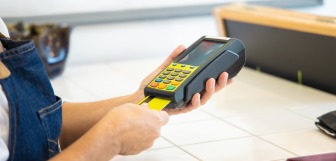Point of Sale Vs Point of Purchase
If you’re in the retail industry (whether online or with brick-and-mortar stores) you’ve probably heard of Point of Sale and Point of Purchase. While they both refer to interactions between customers and businesses, there are important differences between the two.
The right POS systems and POP displays can influence everything from impulse purchases at the checkout counter to shopping cart behavior during a shopping trip. Understanding how POP displays and POS stands interact with customers at various touchpoints in the purchase journey can help you boost sales, raise brand awareness, and encourage last-minute purchases.
In this blog, we’ll explain what POS and POP are so you have a clear understanding, their roles in the purchase process, and how they can impact sales strategies and customer experience. Let's get into it.
Understanding Point of Purchase
Ever gone into a store just to buy one thing and left with a full bag? Maybe you were lining up to pay when all of a sudden, all these POP displays catch your eye. Suddenly, you’re doing some impulse buying and adding things to your shopping cart you didn’t even plan on buying. That’s POP marketing at work.
Types of POP
Now, there are plenty of ways to set up a POP in both physical stores and online. In a brick-and-mortar store, you might see POP stands, dump bins, or POP displays near the checkout counter or at key areas around your retail store. If you don't have a physical location and just operate online, it could be suggested products, flash sales, or special packaging that shows up as you're browsing.
Primary objectives of POP marketing
The main goal of POP marketing is to encourage customers to partake in some impulse buying. Whether it’s grabbing attention with a flashy display or a last-minute deal, POP is all about influencing the customer’s purchase decisions right before they check out and boosting the average spend of your customers. It’s a clever way to increase sales by making it easy for customers to say, “Oh, I’ll take that too!”
Understanding POS
When we talk about POS, we’re referring to the actual spot where a customer completes their POS transaction. This is where the purchase is finalized, and the customer buys the product. In other words, it’s where things go from “I’m looking” to “I’m buying.”
What is the POS?
At its core, POS refers to the place where you make a purchase. In a retail store, the POS display is often the checkout counter where you pay for your items. It could also be a POS stand or a self-checkout kiosk. For online shoppers, the POS is the point where they click to pay for their items, think of it like the final step in the shopping journey.
POS locations and touchpoints
In a retail store, the POS displays can be at the checkout counter, on POS stands, or even throughout the store in high-traffic areas where customers are more likely to make those impulse purchases (particularly if you have mobile payments and tablet POS systems).
In an online store, POS touchpoints happen when you click the purchase button after browsing your products. For both, the idea is to make the transaction as smooth and quick as possible while encouraging customers to keep adding to their shopping cart.
POS system components
A POS system involves more than just the register or button you click to pay. It’s made up of several components that help make the purchase process easy. This can include POS software that tracks sales, transaction security to keep payments safe, and even cloud-based POS systems that let you manage sales from anywhere.
For physical stores, there’s also POS hardware like a cash register, barcode scanners, and receipt printers. These all work together to finalize the sale, keeping the customer’s shopping journey seamless and efficient.
Key Differences Between POP and POS
When it comes to POP and POS, these terms might seem similar, but they actually refer to two different things that play key roles in the purchase process. Let’s break it down.
Conceptual distinctions
A POP display is a form of retail marketing that's all about sparking interest, as a way to raise awareness of products in-store and to influence new or additional purchases. A POS, on the other hand, is the place where the actual sale happens.
Location and placement
POP promotional materials are located all over the store, often near the entrance or aisles, where it can catch your eye. POS is the actual transaction and is always at the checkout, where you make your payment and finalize everything. It's the last step before you leave with your purchase in hand.
Primary goals and functions
The goal of POP marketing is to create moments of surprise or interest, often encouraging you to buy more than you planned. POS is about completing the purchase smoothly and efficiently, whether it’s scanning items at the counter or checking out online.
Customer interaction level
With POP displays, your customers are typically just passing by or glancing at something that catches their eye and consumers decide to make an impulse purchase. POS involves a more direct, active engagement where customers interact with you because they’re making the final decision to purchase.
Key Technologies in POP and POS
Technology plays a huge role in both POP and POS displays. Let’s look at how these systems are evolving and the challenges that come with them.
Technological innovations in POP
POP displays have evolved beyond just posters and shelves. Now, interactive digital screens, augmented reality (AR), and QR codes are used to grab attention and engage customers in new ways. Think of walking into a store and seeing a screen that lets you try on clothes virtually or scan a code for an instant discount.
Advancements in POS systems
POS systems have come a long way from just cash registers. Today, they’re smart, cloud-based, and handle a variety of tasks. They now integrate with online stores, inventory management in real-time, sales analytics, and support mobile payments and self-checkout kiosks. You can even use a POS system to track customer data, run analytics, and improve customer experience. Plus, a lot of modern POS systems integrate with third-party apps like accounting software, POS marketing software, CRM and loyalty programs.
Challenges and Limitations
While technology has brought major improvements, it hasn’t been all smooth sailing. Both POP and POS come with their own set of challenges.
Common POP challenges
The main challenge with POP is placement and visibility. Even the best POP display strengths can’t work if customers don’t see them. It’s all about finding the right spot in your physical location or online space to catch attention. Plus, customers have limited attention spans, so ensuring your purchase displays are eye-catching enough is crucial. There's also the issue of cost. High-tech POP displays can be pricey, and businesses need to see a strong return on investment.
POS system limitations
On the POS side, transaction security is always a concern. With so many payment methods now available, from mobile payments to credit cards and ecommerce transactions, ensuring customer data is protected is a constant challenge. To combat this, look for POS providers that are PCI-DSS compliant.
Plus, while POS systems can integrate with other tools, sometimes these systems don’t play nice with each other, creating headaches for businesses. That's why it’s important to choose a POS provider like Epos Now, which has strong partnerships and a POS integration, ensuring everything works smoothly across your business. This way, you can avoid those tech headaches and keep everything running efficiently.
The role of consumer behavior in POP and POS
Ever wonder why certain items just seem to call your name at the checkout counter or why online stores always seem to know what you’ll buy next? That’s consumer behavior in action. Retailers use sales data and shopping patterns to optimize POP displays and POS interactions, ensuring customers see the right products at the right time.
At the POP level, businesses use attention-grabbing displays and strategic product placements to trigger impulse buys. Meanwhile, at the POS, tracking purchase history and preferences helps personalize recommendations, driving brand loyalty and repeat purchases. The more you understand how customers think, the better you can influence their buying decisions.
Sales analytics: fine-tuning POP and POS for better results
Both POP marketing and POS systems generate a goldmine of data, and smart retailers use sales analytics to make sense of it. Want to know which items sell best at the checkout counter? Which impulse buys bring in the most revenue? Analyzing sales trends helps businesses optimize retail operations, from stocking the right products to adjusting prices and promotions for maximum impact.
POS systems, in particular, offer real-time insights into customer preferences. With advanced analytics, businesses can track the consumer journey, identifying what products are most likely to be bought together (hello, cross-selling opportunities!). This allows retailers to tweak their POP strategies and create irresistible offers that keep customers coming back.
Omnichannel retailing: connecting POP and POS across channels
Customers today aren’t just shopping in-store or online—they’re doing both, often at the same time. That’s where omnichannel retailing comes in. The best retailers ensure that the POP experience is just as engaging online as it is in a physical store. Think of suggested products on an e-commerce site, exclusive online discounts that pop up at checkout, or QR codes in-store that link to digital and in-store promotions.
At the POS, an omnichannel approach means seamless transactions, whether customers are buying via mobile, self-checkout, or even through social media. POS integration with e-commerce platforms ensures a smooth customer experience, no matter where or how they shop.
Mobile payments & technology trends reshaping POS
With the rise of mobile payment solutions, checkout processes are faster and more convenient than ever. Whether it’s tap-to-pay, digital wallets, or in-app purchases, customers expect seamless transactions. This shift is part of the larger retail technology trends reshaping the way businesses operate, from AI-driven POS systems to cashierless stores.
Retailers that stay ahead of these trends can improve the checkout systems and customer satisfaction, reduce wait times, and create frictionless shopping experiences that keep people coming back.
POP and POS are going green
Retailers are catching on, customers care about sustainability. That’s why sustainability in retail is becoming a bigger focus, even in POP marketing and POS technology.
Instead of wasteful cardboard product displays and plastic-heavy packaging, many retailers are moving toward eco-friendly POP displays, like interactive marketing solutions that reduce waste. On the POS side, businesses are adopting paperless receipts, energy-efficient payment terminals, and cloud-based POS systems that cut down on unnecessary point of sale hardware. A greener approach not only helps the planet but also boosts customer trust and loyalty.




